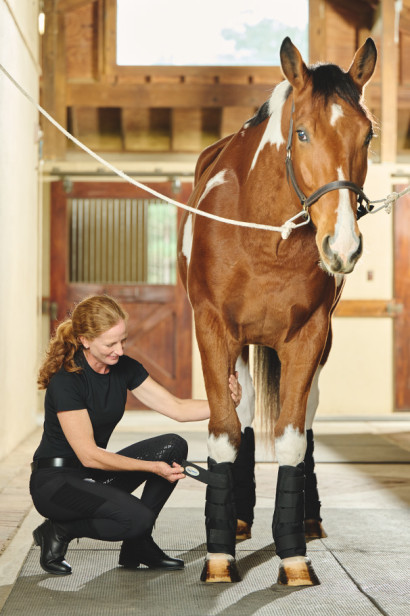Equine Therapy Programs: Transforming Lives One Experience at a Time
Equine Therapy Programs: Transforming Lives One Experience at a Time
Blog Article
Evaluating the Performance of Laser Therapy in Horse Treatment for Injury Rehab
The evaluation of laser therapy's performance in equine injury rehabilitation depends upon multiple factors, including recovery time, discomfort mitigation, and tissue regeneration. Clinical researches recommend significant enhancements in problems like tendonitis and osteoarthritis, credited to enhanced mobile feature and elevated ATP production. Veterinarians often observe exceptional outcomes with laser therapy contrasted to traditional approaches, placing it as an essential aspect in equine treatment. The necessity for constant monitoring and tailored therapy strategies can not be overemphasized. What details professional proof sustains these claims, and how do veterinarians implement these protocols in technique?
Comprehending Laser Therapy
Laser treatment has ended up being a crucial device in veterinary medication, especially in the treatment of equine conditions. Recognized for its non-invasive nature and effectiveness, laser therapy includes the application of particular wavelengths of light to stimulate tissue repair and decrease inflammation. This restorative modality is progressively preferred for its capability to increase the healing procedure in equines dealing with a variety of bone and joint injuries and chronic conditions.
The primary mechanism behind laser therapy is its capability to boost mobile functions. When laser light permeates the skin, it is soaked up by mitochondria, the powerhouse of cells, which brings about enhanced manufacturing of adenosine triphosphate (ATP) This biochemical power increase facilitates mobile repair work and regrowth. Furthermore, laser treatment promotes vasodilation, boosting blood flow and oxygen distribution to damaged tissues, hence quickening recovery.
In equine medicine, laser therapy is especially advantageous for conditions such as tendonitis, osteoarthritis, and injury recovery. The strategy is admired for its pain-relieving residential or commercial properties, permitting equines to gain back movement and function more rapidly. Veterinarians also value its marginal negative effects compared to various other therapy techniques, making it a reputable and risk-free choice for equine treatment.

Exactly How Laser Treatment Functions

Upon absorption, these photons trigger a series of biochemical changes, enhancing mitochondrial feature and resulting in enhanced adenosine triphosphate (ATP) manufacturing. This increase in ATP speeds up mobile metabolism, promoting tissue repair work and regrowth. Furthermore, laser treatment modulates inflammatory feedbacks by impacting cytokine degrees and lowering oxidative anxiety, thereby reducing pain and swelling.
One more significant facet of laser treatment is its duty in boosting microcirculation. The treatment advertises vasodilation, improving blood circulation and oxygen shipment to damaged tissues (Equine Therapy). Check This Out This assists in the elimination of mobile particles and sustains the spreading of fibroblasts and collagen synthesis, vital for injury recovery
Medical Proof
The efficacy of laser therapy in equine therapy has been confirmed via different clinical studies, showcasing its restorative possible across a variety of conditions. A number of controlled trials and observational research studies have actually recorded considerable renovations in tissue repair, pain reduction, and general rehabilitation timelines. A study carried out by Turner et al. (2012) demonstrated that horses treated with low-level laser therapy (LLLT) for ligament injuries showed increased recovery contrasted to those receiving standard treatments. The research highlighted a significant reduction in swelling and improved collagen development.
In a similar way, research study by Johnson and associates (2015) focused on equine muscular tissue injuries, revealing that laser therapy significantly accelerated muscular tissue fiber regrowth and minimized muscle rigidity. Medical analyses have shown that laser therapy can minimize persistent problems such as osteo arthritis.
Vet Insights

Vets additionally appreciate the flexibility of laser treatment. She directs out that laser treatment can be customized to the details requirements of each equine, making certain ideal results.
Furthermore, vets value the capacity to integrate laser treatment with various other treatment techniques. This multimodal approach can enhance overall official website treatment efficiency, giving a comprehensive option for equine rehabilitation. Such recommendations from experienced professionals emphasize the expanding approval and application of laser therapy in equine medicine.
Practical Considerations
A crucial aspect of executing laser treatment in equine therapy includes comprehending the functional factors to consider that guarantee its effectiveness and safety and security. It is essential to pick the suitable laser device, as various kinds vary in wavelength, power, and penetration deepness. Veterinarians need to be well-versed in these specifications to tailor therapy methods efficiently to every injury type
Moreover, the frequency and period of laser treatment sessions require mindful planning to make best use of therapeutic advantages while lessening any kind of potential unfavorable effects. Regular monitoring of the equine's why not try these out response to treatment can assist essential modifications in the treatment routine. Developing a risk-free and controlled environment throughout therapies is additionally important to protect against unintended exposure to laser emissions, which can damage both the equine and the trainer.
Training and accreditation of workers carrying out laser therapy are vital to guarantee appropriate strategy and to promote safety criteria. Furthermore, keeping exact records of each session, including laser settings and observed outcomes, is crucial for examining the overall effectiveness of the treatment and for making data-driven choices.
Conclusion
Laser treatment has arised as a reliable method in equine injury rehab, using considerable benefits in recuperation time, discomfort relief, and cells healing. For optimum outcomes, constant monitoring and customized therapy procedures continue to be vital in leveraging the complete capacity of laser therapy in equine treatment.
Report this page